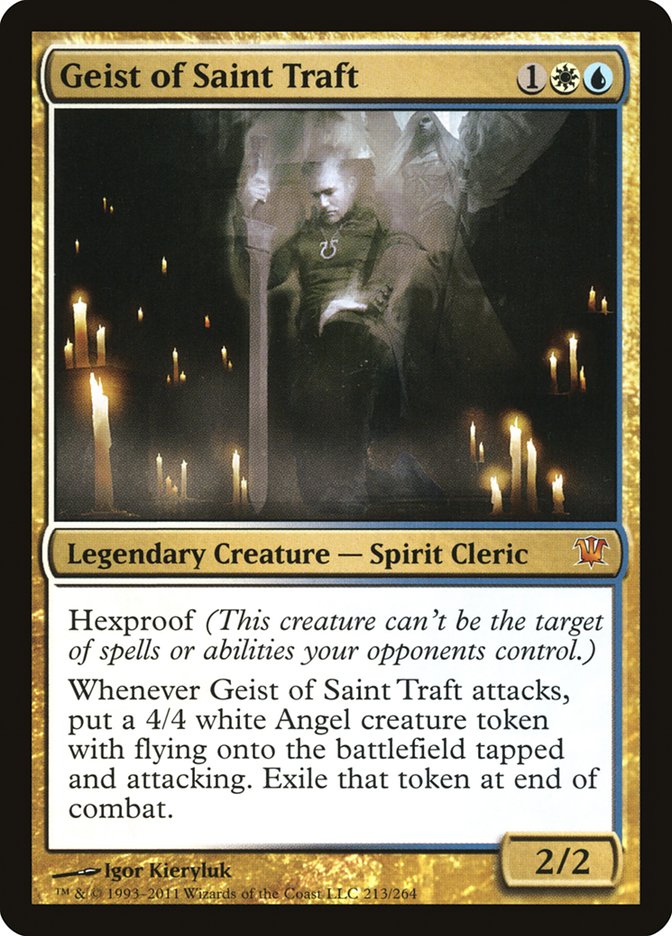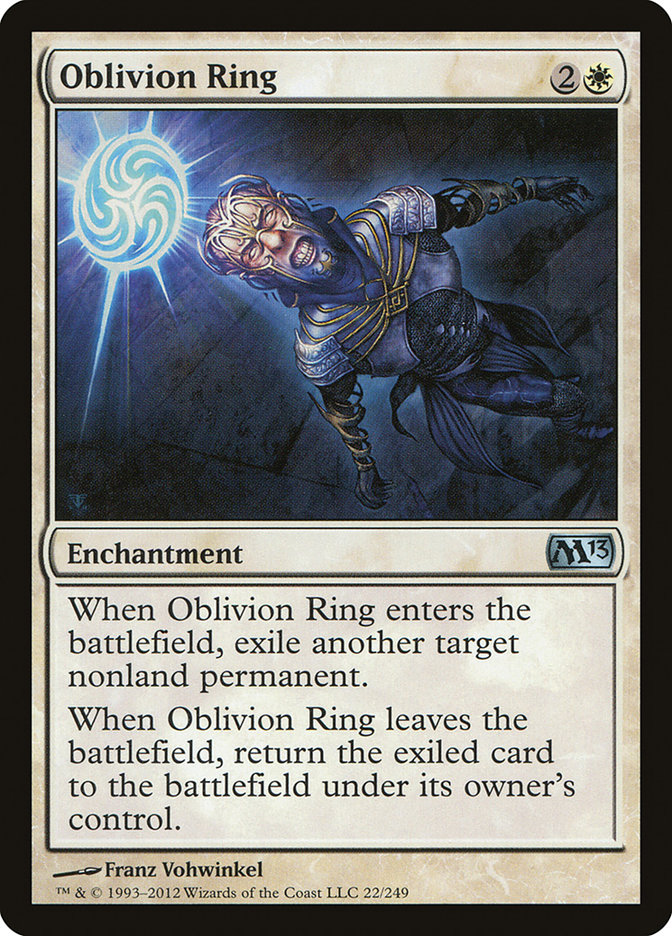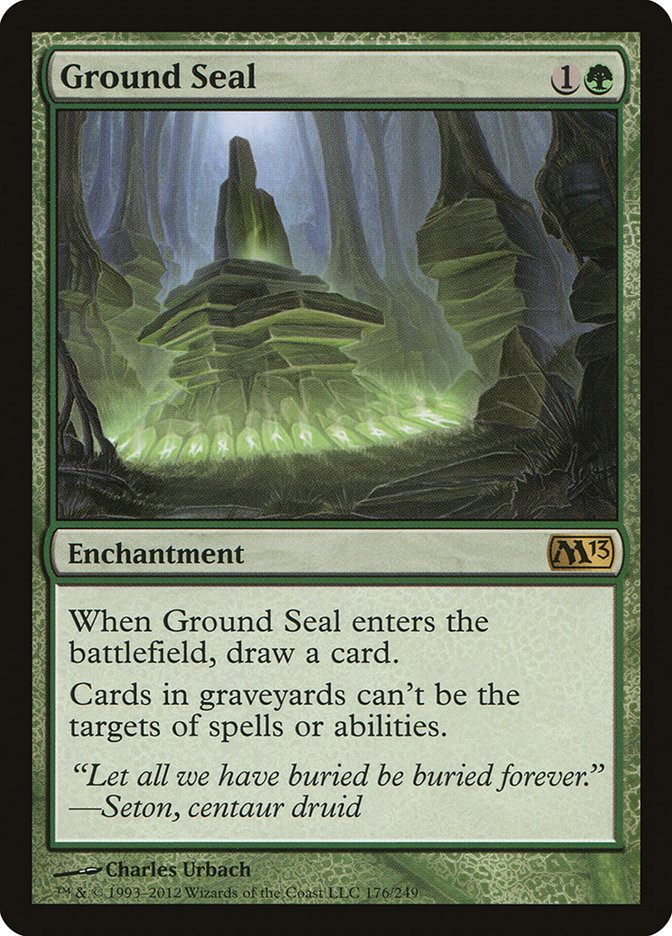Enough with the green decks.
U/W/R Control/Flash
I still like U/W/R, but I have a tough time winning with it in real life despite doing well with it online. Perhaps that’s just because I don’t get enough reps in real life, whereas on Magic Online I get to play as much as I want. For the most part, my competition is stronger online as well.
That said, there are some things in U/W/R that I would never touch again. The “control” version with basically just Aetherling for a win condition is not good. Despite the claims, Aetherling doesn’t beat every board state. The initial mana investment is a pretty high opportunity cost, even for an unkillable win condition. There are some matchups where having Aetherling in your deck will lead to wins, such as control mirrors and potentially Jund, but I am not planning on it stabilizing the board against a creature deck.
As I stated before, it’s difficult to gain complete control with U/W/R (or any control deck for that matter). I took for granted the amount of games I was winning by racing with Angels and Reckoners. Looking back, I wish I kept complete track of exactly how I won every game so that I could check. I bet I’d be surprised.
I’d prefer to play a creatureless control strategy if possible, but that isn’t exactly possible—Ken Yeoh tricked everybody into thinking it was good. Winning games is doable but not easy. The threats are good, and the answers aren’t cheap. Taking total control requires a number of things to go your way.
I used to win matches with U/W/R by being leaner than every other deck out there. I’d use all my mana every turn, creating little advantages here and there, eventually culminating in winning a race or by grinding with Sphinx’s Revelation. Cards like Turn // Burn are the antithesis of that game plan.
With things like Augur of Bolas on defense, Turn // Burn is either a two-for-one or a clean answer to Thragtusk. U/W/R doesn’t want many cards like that if any, which is why I played the minimum number of Supreme Verdicts every week. Cards like that clog up your opener and typically prevent you from playing multiple spells in a turn, which is what allows you to catch up.
In theory, Supreme Verdict should catch you up on its own, but that’s not the case against things like Voice of Resurgence and Thragtusk. I’d prefer to cast Azorius Charm and Pillar of Flame most of the time. Even though you’re using multiple cards, you’re not taking damage. It doesn’t matter how much card advantage you’ve gained at the end of a game if you’re at zero.
Having mostly cheap spells means that post Sphinx’s Revelation you will be able to deal with multiple things. Clunky cards like Tamiyo, Terminus, and Turn // Burn make that less likely and make your Sphinx’s Revelations much worse.
I like Augur of Bolas.
I like Boros Reckoner.
I love Warleader’s Helix.
I love Essence Scatter.
I also like Terminus, but Terminus does not play well with Boros Reckoner or Augur of Bolas. Finding a Terminus with Augur is typically like whiffing on it, at least in 90% of the games. With Boros Reckoner in your deck, you’re probably interested in playing more of an aggro-control role than sweeping the board every turn.
Boros Reckoner and sweepers are obviously a nonbo to some extent, but Boros Reckoner also encourages them to overcommit, which makes your sweepers fairly potent. That’s true with Supreme Verdict at least but not Terminus unless you get lucky enough to miracle it.
That leaves us with this:
Creatures (12)
Lands (23)
Spells (25)

I still like Thought Scour and continually feel punished whenever I play without it. Apparently, I never learn my lesson. I think, “26 lands with only six cantrips will be fine. I won’t miss land drops, and I’ll use my mana every turn.” Obviously, the exact opposite happens, but alas—this is where I’m at.
Harvest Pyre is obviously awesome, but mostly when you plan on playing longer games. Standard is relatively fast right now, so I’d rather have the higher variance Blasphemous Act to blow out my opponents. Counting on it as a sweeper against decks like R/G Aggro will likely get you in trouble. By the time their board is flooded with enough guys to make the Act cheap, you will probably be dead.
Other than that, this deck is reasonably stock, and I think that’s where you want to be. Return to the basics of what made the deck good in the first place. The format has shifted around Junk Reanimator, and the most important thing in the format is no longer about how to win that mirror match. The decks are very similar to what they were three months ago.
Since that’s the case, my sideboard has remained relatively unchanged. The Jace and Aetherling that are present for control matchups could be taken out unless Rob Seder’s Open win in Philly with Esper somehow causes the format to shift drastically. If that’s the case, you’re going to want Negates in addition to Dispel and some difficult to beat win conditions.
The fourth Pillar is in the sideboard because while many decks play things you need to kill early there are also decks that don’t. Against those, drawing multiple Pillars will not be good for you. Against the decks where Pillar is excellent, you have a solid shot of beating them anyway. I definitely want the fourth after sideboard though. Izzet Staticasters, the third Warleader’s Helix, and the second Supreme Verdict are also fantastic against aggro decks.
Clones and Rest in Peaces are the go-to plan against Junk Reanimator. Additionally, Clone is solid against any Thragtusk or Geist deck, while Rest in Peace destroys The Aristocrats. I don’t see any reason to not play those cards.
However, another viable sideboard strategy would be Geist of Saint Traft and Thundermaw Hellkite. Those would come in against other control decks, but you could also sideboard in Geists against Jund or Junk Reanimator if you’re feeling frisky. Regardless, Thundermaws are coming in for those matchups.
Of course, the “man plan” can be an attractive option, but I don’t like how it narrows your in-game options.
If I were going to Grand Prix Miami, I would probably play something similar. Jund, Naya, The Aristocrats, and Junk Reanimator are all very good options as well. Personally, I feel more comfortable with U/W/R, but you should do what works for you. Lots of people have been asking me for an update, so there it is.
U/W/R Geist
I dislike Turn // Burn despite it being a perfectly reasonable card. You know what that card is good with?
Creatures (13)
Planeswalkers (2)
Lands (24)
Spells (21)
- 1 Dissipate
- 2 Syncopate
- 3 Pillar of Flame
- 3 Searing Spear
- 1 Mizzium Mortars
- 4 Azorius Charm
- 1 Detention Sphere
- 2 Sphinx's Revelation
- 2 Turn
- 2 Warleader's Helix
Sideboard

I’ll admit up front that I have no idea how to build these decks correctly. Todd Anderson versions of this deck always look awful, Alex’s version has only 24 lands and no Thought Scours, and Mark Nestico did well in a reasonably large tournament with it too.
After playing it some on Magic Online, I came to the conclusion that 24 lands was too greedy. This is mostly an aggressive deck in that it has basically no way to come back from behind if it stumbles. Despite being an aggro deck, this deck needs to make every land drop up until four (and probably five). Some velocity is in order.
Since Geist is doing most of the heavy lifting, I’m surprised at the amount of Geist-based lists that don’t run Boros Reckoner as well. In addition to being a resilient threat against green-based decks, Reckoner allows you to sideboard in the other pieces of the Blasphemous Act combo. Against aggro, it’s a brick wall. The games where you are threat light are very difficult to win, so it wouldn’t surprise me if something like two Boros Reckoners is the correct number maindeck.
It feels like the deck wants a sweeper, but do you play Bonfire of the Damned? Mizzium Mortars? Nothing? These are questions that I don’t know the answers to.
U/W Control/Flash
Underrated player Dustin Faeder has been playing this on Magic Online to great success:
Creatures (8)
Lands (17)
Spells (35)
- 4 Plains
- 4 Dissipate
- 6 Island
- 4 Syncopate
- 4 Think Twice
- 4 Terminus
- 4 Azorius Charm
- 3 Sphinx's Revelation
- 2 Renounce the Guilds
Sideboard

Dustin builds decks differently than I do, and that’s something I can certainly appreciate. He goes hard on Terminus, which I respect, but also includes the full amount of Augurs. In this case, I’m going to say that it’s fine since he has 21 other spells he can Augur into.
Eight hard counterspells is a ton, but they are very good right now. I’d probably experiment with some Essence Scatters, but Dustin maxes out on the cards he thinks are better, which I can certainly respect.
The use of zero Snapcaster Mages makes sense because there aren’t many cheap spells in the deck, plus it sets him up nicely to bring in his four Rest in Peaces. From experience playing similar decks, even if Snapcaster wasn’t fantastic in my deck, I’d want one or two to function as additional Sphinx’s Revelations. The first Revelation doesn’t normally win you the game—it just buys you time until the second Revelation shows up—so Snapcaster is invaluable there. To be fair though, with max Augur of Bolas and Restoration Angel, he should be able to find them.
The old standby has also been doing pretty well lately:
Creatures (12)
Lands (11)
Spells (37)
- 5 Plains
- 2 Dissipate
- 8 Island
- 1 Unsummon
- 2 Rewind
- 2 Syncopate
- 2 Think Twice
- 1 Runechanter's Pike
- 3 Thought Scour
- 4 Azorius Charm
- 2 Supreme Verdict
- 3 Sphinx's Revelation
- 2 Renounce the Guilds
Sideboard

The theory is that since you can’t kill everything you shouldn’t even bother trying. Renounce the Guilds kills some of the crazy stuff in the format, while Unsummon and Supreme Verdict buy you time. As it turns out, Runechanter’s Pike still kills people.
Bant Control
There are two good options out there:
Creatures (8)
Lands (23)
Spells (29)

Creatures (8)
Lands (25)
Spells (27)
- 2 Dissipate
- 2 Island
- 4 Farseek
- 1 Elixir of Immortality
- 3 Terminus
- 3 Azorius Charm
- 3 Supreme Verdict
- 4 Sphinx's Revelation
- 1 Selesnya Charm
- 4 Urban Evolution
Sideboard

Of these, clearly Chi Hoi Yim is the wildest. He’s playing virtually a Turbo Fog shell without the Fogs, at least in his maindeck. Recognizing Terminus as a powerful option is step one in a deck without much spot removal. With these decks, you need your cards to be powerful instead of cheap and consistent. It’s surprising that he had a plethora of Augurs and Snapcasters, aka value creatures. I’d be more interested in what Reid Duke is doing, which is jamming Thragtusks.
But if you’re playing Fogs, that’s a different story.
Reid’s deck looks like a Reid deck, which I guess makes sense since he built it.
The Oblivion Rings maindeck over Detention Sphere complement the sideboard Renounce the Guilds quite nicely. Maindeck Ground Seal makes sense, although Reid has been known to maindeck Rest in Peace as well. For the sideboard, I’d prefer to see Rest in Peace over Ground Seal because you typically want the more high-impact card, plus The Aristocrats is a difficult matchup. However, Ground Seal lines up much better against Acidic Slime.
I might pay more respect to aggro by playing an additional Terminus somewhere, but the Rhox Faithmenders compensate for that somewhat.
Azorius Charm in the sideboard is the only other thing I can nitpick. It’s not a powerful card, nor will its presence dictate whether you win or lose a game. If Reid wrote out a sideboarding guide and he needed a cycler when he had too many dead cards and a card against aggro, then it makes sense. As is, I don’t approve.
Grixis Control
The small amount of Grixis out there has largely disappeared. As it turned out, despite Olivia Voldaren and Aetherling being well positioned against the format, the lack of a good drawer, good sweepers, and life gain meant that it couldn’t compete in the format.
There are small ball card drawers like Think Twice and Desperate Ravings; there are also planeswalkers. For life gain, you can play a heavier black base and Vampire Nighthawk. If you need a sweeper, Barter in Blood and Rolling Temblor are your best options.
Most of the cards I’ve named have been role players in some decks, but they are never the focal point. That’s because none of those cards are very powerful and their effectiveness depends on whether you’re facing the right matchup.
Grixis can win games by everything lining up well, but I wouldn’t take that chance.
All in all, I don’t think things are as bleak for control as people make them out to be. Sphinx’s Revelation is far from “unplayable.” As control players, we just have to work a little harder for our wins, but that’s what being a control player is all about.
GerryT
@G3RRYT on Twitter




